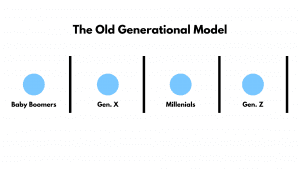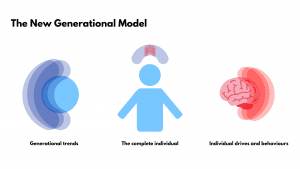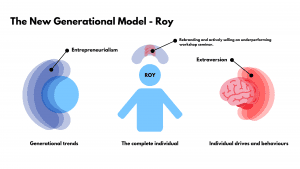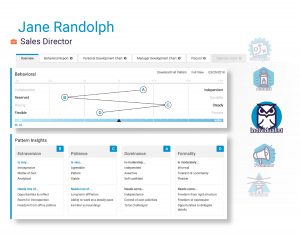How to Actually Motivate Your Generational Workforce
By Thomas MacIntosh |
4.5 min read
How to Actually Motivate Your Generational Workforce
The Myth of the Workplace Age Barrier
Ah the age barrier. The world’s largest, strongest, and most impenetrable wall known to humankind. It’s actually not even a real barrier, but why take away its glory?
An annual report from Boston-based analytics company The Predictive Index found that employees generally don’t feel any better or worse working inter-generationally. [1]
However, for some reason our mutually-held concept of the generational workplace looks like a close up of the (now dreaded) American workplace of the 1980s.

Each generation is separate, unable to break the barriers of the next, and unable to connect to those of the past. This idea is built upon the notion that each generation is only molded by broad stroke trends and experiences, and that at the end of the process we are merely separate subsets of humans who happen to share the same form and language.
This (obviously) isn’t true, but, is what happens when we pigeonhole generations in the workforce to their “top ten workplace characteristics.”
To combat this, the average manager goes through the following process in order to try and understand their generational workforce.
- A Google search for “Characteristics of Generation _________________.”
- A reading of an article entitled, “The Top _____ Things Generation ______ Wants in the Workplace.”
These articles are difficult to miss online, especially across management-centric platforms like LinkedIn. Now, it is necessary to clarify that they do in fact provide accurate and helpful broad stroke ideas about the needs of generational talent. However, the more important use of these characteristics is their use in the context of the individual.
The forward thinking manager does not only understand the generation they manage, or the individual they manage, but instead, the combination of generational characteristics and unique drives of each employee. This will create a powerhouse generational team that can:
- Break the cross-generational boundaries of the office.
- Take advantage of each generation’s unique strength.
- Give each employee a burning love for what they do.
For example, Generation Z is, generally, more entrepreneurial than Generation X. The driver of this trend was the falling barriers to entry that came with the internet. In one day, armed with only a wifi-connection, a Gen. Z entrepreneur can have a business ID, website, promotional social-media, an online service, and a business email account. This ease has driven Gen. Z’s ability to be entrepreneurial, and thus molded the generation’s love for entrepreneurialism.
However, this idea won’t hold true for every Gen. Z employee in your workforce. This is where the issue in broad-stroking a generation generally lies. By simply reading this fact, and then directing your Gen. Z report to, “create a new product line for next quarter,” you may be completely terrifying them, even if the intention is to inspire them.
Fairly obviously, just because a characteristic is identified for a specific generation, doesn’t mean it will hold for everyone. The real key is in the individual themselves, within the context of their generation. The dual-context model gives managers a framework for seeing their individual within their generation, giving them the ability to visualize connections, and make better use of both the personal and generational talent.
The key is to understand how their personality fits with the broad stroke trend, and understanding and being aware of each of each.
For example, if you know Racheal is detail-oriented, and you understand how Generation Z looks for managers who can be a career coach and mentor, sitting down with Racheal once a month to go over goals, planning, and KPIs will leave her feeling inspired and valued. She will probably stay longer to take advantage of the detailed career planning she is receiving, which is playing to her generational characteristics, and personal needs and drives.

The creative thinking key is in the middle of the model. By finding the managerial style or connection point between the generational trend, and the individual, managers can unlock the true power of their generational workforce.
What if Roy, your newest Generation Z hire, is extremely extroverted? On top of that, you know that Generation Z will be entrepreneurial. By understanding Roy’s extroversion within the context of the generation, you may realize that you could let Roy rebrand and actively sell an underperforming workshop seminar your company sells. By giving him the reigns to see the big picture and work with clients, you’re giving him a double shot of people-time and entrepreneurialism.

But, how do you identify a single individual’s needs and drives?
The Predictive Index Behavioural Assessment identifies combinations of four traits in an individual: their Assertiveness, Extraversion, Patience, and Detail-Orientation. From there, a complex algorithm backed by over 50 years of behavioural science, and over 500 accuracy studies, creates a complete model of an individual’s drives and needs. The AI function of The Predictive Index can then use this model in order to create detailed management strategies, individualized to a single employee.
To try the Predictive Index for free on your young group of employees, contact Lauren Danes at ldanes@predictivesuccess.com and mention this article.

Sources:
[1] “People Management Study Results.” The Predictive Index. Accessed October 19, 2019. https://www.predictiveindex.com/management-survey-2018/.
Related Blogs
Top 20 Questions to Ask your Boss
Top 20 Questions to Ask Your Boss—Backed by The Predictive Index Whether you're stepping into a new role, joining a fresh team, or just aiming to build a stronger relationship with your current
What Are Leadership Best Practices?
Leadership Best Practices Relating to The Predictive Index: Insights from Predictive Success Effective leadership is the bedrock of any successful organization. Leaders are the visionaries who guide their teams, the decision-makers who drive change, and
What Is The Meaning of Emotional Capacity & How to Best Build It?
What Is the Meaning of Emotional Capacity & How to Best Build It? Emotional capacity is the ability to manage emotions effectively, understand the emotions of others, and remain resilient in the face of stress


